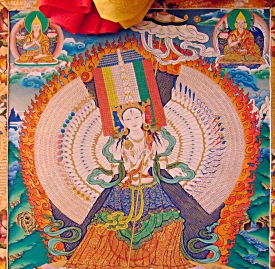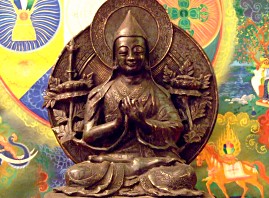 To view this text in English, you may
want to try the automatic translation
with help of translate.google.com.
To view this text in English, you may
want to try the automatic translation
with help of translate.google.com.
Sitatapatras Schirm schützt die Menschheit vor ungünstigen astrologischen Ereignissen, die der Gesundheit
und innerem und Weltfrieden schaden können. Sitatapatra schützt die Welt vor biologischen, chemischen und nuklearen Gefahren,
ökonomischen und Informations-Kriegen und Terrorismus. Sie verteidigt die Länder und Menschen Afrikas, des Mittleren Ostens,
Asiens, Australiens, Europas und Amerikas gegen Gefahr und Zerstörung. Ihre Regenbogen-Aura umschließt den gesamten Planeten
und heilt und reinigt die fünf Elemente, befriedet zornvolle Menschen, erzeugt Stabilität und bekräftigt alle Menschen,
zusammen zu arbeiten, um die Ziele der Vereinten Nationen zu realisieren, Frieden in der Welt zu schaffen.
Quelle: T.Y.S. Lama Gangchen, „NgalSo Tantric Selfhealing – Practice of Sitatapatra – The White Umbrella Goddess”
Sitatapatra wohnen (unter anderem) diese Eigenschaften inne. Sich gegenwärtig zu sein, dass es sich um eine
archetypische Beschreibung handelt, ist wichtig. Praktiziert man das Sadhana (Meditationsanleitung) und rezitiert
ihr Mantra, um diese Energie durch Kraft der eigenen Motivation und Konzentration zu erzeugen, so trägt man zur
Manifestation dieser positiven Einflüsse in unserer Welt bei.
Am 10. und 11. Februar 2007 gewährte Lama Michel
im Albagnano Heil- und Meditationszentrum Unterweisungen zu den folgenden Themen:
- Welcher Motivation bedarf es, um tantrische Methoden kraftvoll zu verwirklichen?
- Klare Einsicht in das Fehlen unabhängiger Existenz aller Phänomene – Leerheit,
- Übertragung der Praxis von Sitatapatra und ausführliche Erläuterungen dazu.
Auf unser Nachfragen gab Lama Michel die Zustimmung, die Punkte I. und II. hier vollständig im
Original-Audio zum Download bereitzustellen.
Viel Freude und Konzentration beim Hören!
Um den größtmöglichen Nutzen aus diesen
Darlegungen zu ziehen, bedarf es der drei Punkte Hören, Verstehen und
Meditation (tiefes Durchdenken). Genauso wie Boot, Ruder und Muskelkraft unabdingbar zusammen gehören, um ein Wasser
zu überqueren, solange man noch nicht darüber schweben kann. 
Technische Probleme oder Ideen zur besseren Darstellung? Bitte kurze Rückmeldung. Vielen Dank!

 Lama Gangchen Peace Times
Lama Gangchen Peace Times
 Lama Gangchen Books & Booklets
Lama Gangchen Books & Booklets 



 Help in Action
Help in Action

 World Peace Congress
World Peace Congress
 Congress Integrative Psychiatry
Congress Integrative Psychiatry Albagnano Healing Meditation Center
Albagnano Healing Meditation Center
 Gangchen Peace Art
Gangchen Peace Art Healing Protection Jewels
Healing Protection Jewels Kunpen Lama Gangchen Mailand
Kunpen Lama Gangchen Mailand Centro Buddha Della Medicina Torino
Centro Buddha Della Medicina Torino
 NgalSo Healing Art
NgalSo Healing Art Inner peace education for kids
Inner peace education for kids Lama Caroline Homepage
Lama Caroline Homepage White Tara Group London
White Tara Group London Entorno de Paz, Andalusia, Spain
Entorno de Paz, Andalusia, Spain Son de Paz, Spain
Son de Paz, Spain Centro de Dharma da Paz, Brazil
Centro de Dharma da Paz, Brazil Documentário Herança Espiritual
Documentário Herança Espiritual Budismo Tibetano, Brazil
Budismo Tibetano, Brazil Albagnano Healing Meditation Center
Albagnano Healing Meditation Center Help in Action e.V.
Help in Action e.V. Dharmachakra e.V. Schwalmbach
Dharmachakra e.V. Schwalmbach Ganden Tashi Choeling
Ganden Tashi Choeling Yeshe Lam Chen e.V. München
Yeshe Lam Chen e.V. München Deutschsprachige Literatur
Deutschsprachige Literatur Peaceworld CTM
Peaceworld CTM www.spiritualgifts.de (Online-Shop)
www.spiritualgifts.de (Online-Shop)

